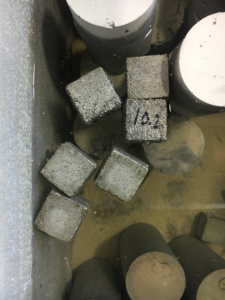 Jeremy has been in the process of performing a structural anlysis of the canoe under the most critical loading condition to find the maximum compressive and tensile stresses. These stresses will help determine the design strength of the final concrete mix that the mix design team should achieve. The critical condition consists of 4 paddler loads conservatively assumed 200 pounds each acting at 20%, 35%, 65%, and 80% of the canoe’s length. The self-weight of the canoe and the bouyancy load is parabolically distributed with based on the changing width and geometry with respect to the length of the canoe. From this loading condition, the shear diagram was developed to determine the moment diagram. The moment diagram was found by integrating all of the shear equations between each of paddler loads. The maximum positive and negative moments will be analyzed and used to find the maximum compressive and tensile stresses.
Jeremy has been in the process of performing a structural anlysis of the canoe under the most critical loading condition to find the maximum compressive and tensile stresses. These stresses will help determine the design strength of the final concrete mix that the mix design team should achieve. The critical condition consists of 4 paddler loads conservatively assumed 200 pounds each acting at 20%, 35%, 65%, and 80% of the canoe’s length. The self-weight of the canoe and the bouyancy load is parabolically distributed with based on the changing width and geometry with respect to the length of the canoe. From this loading condition, the shear diagram was developed to determine the moment diagram. The moment diagram was found by integrating all of the shear equations between each of paddler loads. The maximum positive and negative moments will be analyzed and used to find the maximum compressive and tensile stresses.
Monthly Archives: November 2018
11/13 Narrowing down the Final Mixes
 The Mix Design team has come closer to a final mix over the past month. With their most recent trials, they have achieved multiple mixes that float in water. Mix 8, 9, and 10 have proven to be the most successful in terms of floatability. It is important to note that all of the mixes are in compliance with the 2019 ASCE Rules and Regulations, especially the use of 25% aggregates, discluding microspheres and cenospheres, and mineral fillers.
The Mix Design team has come closer to a final mix over the past month. With their most recent trials, they have achieved multiple mixes that float in water. Mix 8, 9, and 10 have proven to be the most successful in terms of floatability. It is important to note that all of the mixes are in compliance with the 2019 ASCE Rules and Regulations, especially the use of 25% aggregates, discluding microspheres and cenospheres, and mineral fillers.
Mix 8 has an average compressive strength of 252 psi, with a specific weight of 60.11 pcf. This design is very close to the specific weight of water and proved to be more risky and difficult when placing the cubes in water. The team believes a slightly lighter mix will increase the floatability while maintaining the integrity of its strength. Mix 9 was significantly below the specific weight of water, with its own specific weight of 51.11 pcf. It has a very low compressive strength of 68.67 psi. This mix is extreme, and the team can afford to make it heavier in order to fulfill the need for a higher compressive strength.
Mix 10 is still curing in the water bath but was measured to have a specific weight of 55.8 pcf. However, there were major air gaps seen in some of the cubes when removed from the mold, which can make the specific weight appear less than it is in reality, and decrease the compressive strength. The cubes did float in water, so recreating this mix and further testing would be needed to determine more accurate properties. The team has high hopes for Mix 10 in regards to increased strength when compared with Mix 9, as Mix 10 was made to mimic Mix 9, with the addition of the cementitious material Silica Fume, a cement that increases strength.
As the team narrows down their design, modifications to the past few mixes, particularly Mix 8 and 10, will be made in order to determine an accurate specific weight, and maximize both strength and floatability.
